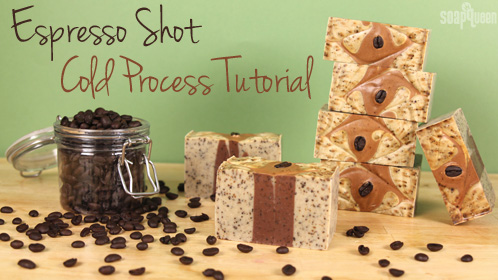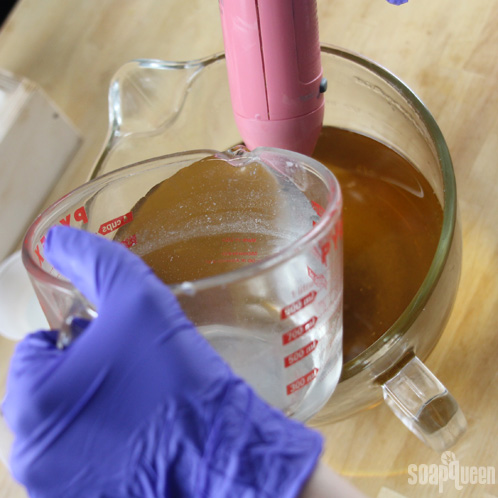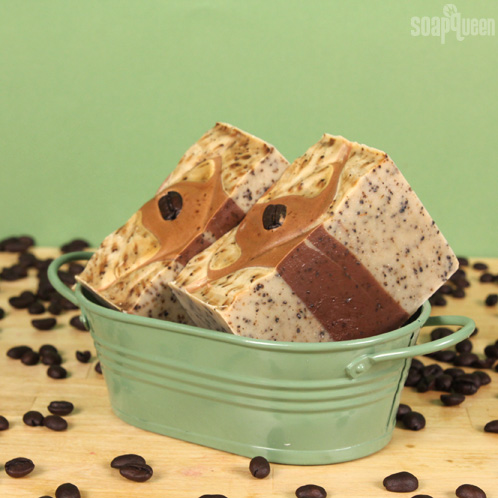
What You’ll Need:
5.5 oz. Cocoa Butter
13.7 oz. Coconut Oil
2.7 oz. Coffee Butter
2.7 oz. Hazelnut Oil
16.5 oz. Olive Oil
13.7 oz. Palm Oil
7.7 oz. Sodium Hydroxide
18.1 oz. distilled water
3.5 oz. Espresso Fragrance Oil
5 lb. Wood Log Mold with Slide Bottom and Silicone Liner
3 tbsp. coffee grounds
If you’ve never made Cold Process soap before, check out our FREE four part SoapQueen.tv series on Cold Process Soapmaking, especially the episode on lye safety. Bramble Berry also carries a wide range of books on the topic, including Soap Crafting. You can also checkout the digital downloads.
SAFETY FIRST: Suit up for safety! That includes goggles, gloves and long sleeves. Make sure kids, pets, and other distractions and tripping hazards are out of the house or don’t have access to your soaping space. Make sure to always soap in a well-ventilated area.

COLOR PREP: To make sure the Titanium Dioxide blends smoothly into the soap, we recommend micronizing it beforehand. This is an optional step, but it does help prevent the Titanium Dioxide from clumping. To micronize the colorant, use a coffee grinder to blend the colorant to break up any clumps of color and prevent streaks of white from showing in the final soap. When the color is micronized, mix 1 teaspoon of it into 1 tablespoon of a lightweight oil like sweet almond oil. Mix 1 teaspoon of brown oxide into 1 tablespoon of a lightweight oil. Use a mini mixer to incorporate.
COFFEE GROUNDS: You can use dry or used coffee grounds for this soap. If you use dry coffee grounds like we did, they can “bleed” and form a small ring of color around them. To avoid this, use leftover coffee grounds.
ONE: Carefully and slowly add the lye to the water and stir until the lye is fully dissolved and the liquid is completely clear. Set the lye and water aside to cool.
TWO: Combine the coffee butter, cocoa butter, coconut oil, hazelnut oil, olive oil and palm oils. Remember to fully melt and mix your entire container of palm oil before adding it to the mixture. Once the oils and lye water have cooled to 130 degrees or below (and ideally within 10 degrees of each other), add the lye water to the oils. Stick blend until you reach thin trace. If you want a harder bar of soap that releases faster from the mold, add sodium lactate to your cooled lye water. Add 1 teaspoon of sodium lactate per pound of oils in the recipe. In this recipe, you will need about about 3 tsp. of sodium lactate.

 THREE: When the soap is at thin trace, pour about 3 cups of it in a second container.
THREE: When the soap is at thin trace, pour about 3 cups of it in a second container.

FOUR: Add 1 tbs. of the coffee grounds to the small container. Add about 2 tbs. of coffee grounds to the larger container of soap. Use a whisk to combine the coffee grounds in both containers.

FIVE: In the larger container, mix 3 tps. of the dispersed Titanium Dioxide in with a whisk.

SIX: In the smaller container, mix in 3 tps. dispersed Brown Oxide with a whisk.

SEVEN: Split the Espresso Fragrance Oil evenly between the two containers. Use a whisk to fully incorporate the fragrance.

EIGHT: Slowly and carefully pour the brown colored soap in the middle of the Multi-Pour Sectioning Tool. Alternate pouring from each end to help the soap disperse evenly.

NINE: When the middle section is full of soap, pour the white soap in the outside sections.

TEN: Pour the soap slowly and carefully. Alternate pouring the soap in different ends of the mold to evenly disperse the soap.

ELEVEN: When all three sections are full, carefully pull the center piece straight up and out of the soap. Set the piece aside.
 TWELVE: Carefully remove the long center dividers straight up and then set aside.
TWELVE: Carefully remove the long center dividers straight up and then set aside.
 THIRTEEN: Remove the small end pieces straight out and then set aside.
THIRTEEN: Remove the small end pieces straight out and then set aside.
 FOURTEEN: When the Multi Pour Sectioning Tool is removed, tap the mold firmly to evenly distribute the soap and pop any air bubbles. In the corner of your mold, insert a chopstick or dowel to the bottom of the mold. Make a zig-zag pattern down the mold lengthwise at a 45 degree angle.
FOURTEEN: When the Multi Pour Sectioning Tool is removed, tap the mold firmly to evenly distribute the soap and pop any air bubbles. In the corner of your mold, insert a chopstick or dowel to the bottom of the mold. Make a zig-zag pattern down the mold lengthwise at a 45 degree angle.

 FIFTEEN: When you finish the zig-zag, insert the chopstick in the opposite corner on the same end of the mold you started with. Cross through the lines with the chopstick to create an argyle-like design.
FIFTEEN: When you finish the zig-zag, insert the chopstick in the opposite corner on the same end of the mold you started with. Cross through the lines with the chopstick to create an argyle-like design.
 SIXTEEN: Carefully put a coffee bean in the center of each swirl. Spray the soap with 99% isopropyl alcohol to help prevent soda ash.
SIXTEEN: Carefully put a coffee bean in the center of each swirl. Spray the soap with 99% isopropyl alcohol to help prevent soda ash.

 SEVENTEEN: Let the soap sit in the mold for 3-4 days and then unmold. To get a coffee bean in the center of each bar, cut the soap between each bean. Let the bars cure for 4-6 weeks. Enjoy!
SEVENTEEN: Let the soap sit in the mold for 3-4 days and then unmold. To get a coffee bean in the center of each bar, cut the soap between each bean. Let the bars cure for 4-6 weeks. Enjoy!

